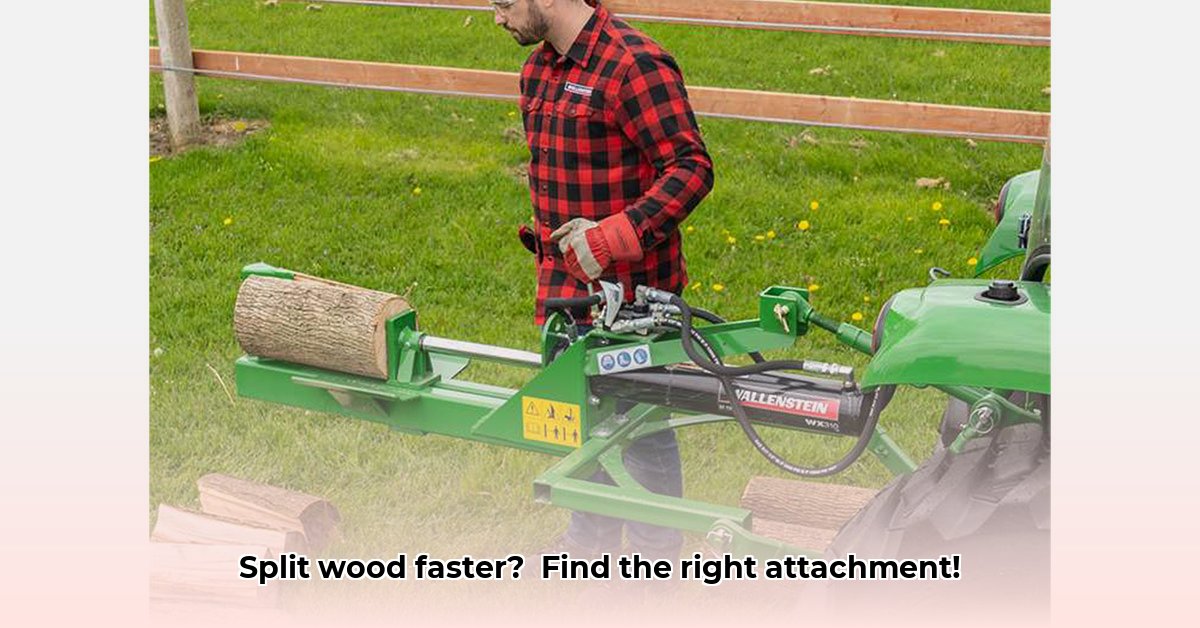
Stop wrestling with those stubborn logs! Imagine splitting firewood in a fraction of the time, with less strain, and significantly increased efficiency. That's the power of a tractor-powered log splitter. This comprehensive guide will equip you with the knowledge to select the perfect splitter for your needs, regardless of your experience level. We'll dissect the two primary types—3-point hitch and PTO—highlighting their advantages and disadvantages, and guiding you through the decision-making process. For more on 3-point hitch splitters, check out this helpful resource: 3-point hitch splitters. Get ready to say goodbye to backaches and hello to faster, easier firewood!
Understanding Your Options: 3-Point Hitch vs. PTO Log Splitters
Two primary methods power tractor log splitters: direct hydraulic power from your tractor's 3-point hitch or an independent hydraulic pump driven by your tractor's PTO (Power Take-Off) shaft. Let's examine each.
3-Point Hitch Log Splitters: The Direct Connection
These splitters attach directly to your tractor's 3-point hitch, similar to other implements. The tractor's hydraulic system directly powers the splitting ram.
Pros:
- Speed: Generally faster splitting cycles due to direct hydraulic power.
- Simplicity: Relatively straightforward setup and connection.
Cons:
- Limited Compatibility: Requires a tractor with adequate hydraulic capacity (GPM - gallons per minute) and horsepower.
- Higher Initial Cost: Potentially more expensive than PTO models.
PTO Log Splitters: The Versatile Choice
PTO log splitters use a separate hydraulic pump driven by your tractor's PTO shaft. This pump powers the splitting ram.
Pros:
- Compatibility: Compatible with a wider range of tractors, even those with limited hydraulic capacity.
- Hydraulic Capacity Flexibility: Ideal for tractors with less powerful hydraulic systems.
Cons:
- Speed: Potentially slower splitting cycles due to the added hydraulic pump.
- Complexity: The additional pump adds complexity to the setup and potential maintenance requirements.
Comparing the Key Differences: A Head-to-Head Look
This table summarizes the key differences between 3-point hitch and PTO log splitters:
| Feature | 3-Point Hitch Splitter | PTO Splitter |
|---|---|---|
| Power Source | Tractor's Hydraulic System | External Hydraulic Pump (PTO-driven) |
| Typical Splitting Speed | Generally Faster | Generally Slower |
| Tractor Compatibility | More limited | More versatile |
| Initial Cost | Typically Higher | Typically Lower |
| Maintenance | Simpler; less frequent maintenance | Potentially more complex; more frequent maintenance |
| Installation | Usually simple and direct | Requires mounting the hydraulic pump |
Choosing the Right Log Splitter for Your Needs: A Step-by-Step Guide
Selecting the right log splitter involves careful consideration of several factors:
Assess Your Wood-Splitting Needs: How much firewood do you need to split annually? This determines the required splitting force and speed. Infrequent use may justify a simpler, less expensive model, while high-volume splitting necessitates a more powerful and faster unit.
Evaluate Your Tractor's Capabilities: Check your tractor's horsepower (HP) and hydraulic flow rate (GPM). Insufficient power will result in slow splitting and potential damage to your equipment. Consult your tractor's manual.
Consider Your Budget: Account for the initial purchase cost, ongoing maintenance expenses, and potential fuel consumption.
Log Size: The typical size of the logs you’ll be splitting impacts the required splitting force. Larger logs require a more powerful splitter.
Choose Your Type: Select a 3-point hitch splitter if your tractor has sufficient hydraulic capacity and speed is paramount. Choose a PTO splitter if your tractor's hydraulic capacity is limited or you need greater compatibility.
Research Specific Models: Once you've narrowed your choices, research specific models and their features.
Safety and Maintenance: Prioritizing Safe Operation and Longevity
Safety is paramount. Always:
- Wear Personal Protective Equipment (PPE): Use safety glasses, gloves, sturdy footwear, and hearing protection.
- Read the Owner's Manual: Thoroughly understand the manufacturer's instructions before operating the log splitter.
- Maintain Safe Distance: Never reach into the splitting zone while the splitter is in operation.
Regular maintenance is crucial:
- Check Hydraulic Fluid Levels: Inspect and maintain proper hydraulic fluid levels regularly.
- Lubricate Moving Parts: Lubricate all moving parts according to the manufacturer's recommendations.
- Address Leaks Immediately: Repair any hydraulic leaks promptly to prevent damage and ensure safe operation.
Conclusion: Harnessing the Power of Efficient Firewood Processing
Tractor-powered log splitters significantly increase the efficiency and ease of firewood processing. By carefully considering your needs, evaluating your tractor's capabilities, and prioritizing safety, you can select the ideal log splitter to meet your requirements. Remember to research specific models and consult with equipment dealers to find the perfect fit for your individual circumstances. Start splitting smarter, not harder!